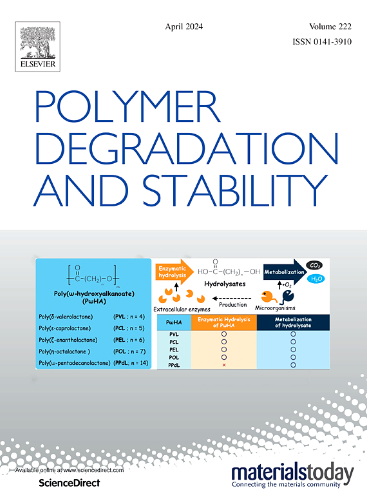环氧树脂用高效聚磷腈共价三嗪阻燃剂:苯环的双面作用及阻燃机理
IF 6.3
2区 化学
Q1 POLYMER SCIENCE
引用次数: 0
摘要
尽管已经取得了很大的进展,但在低添加量下制造具有优异阻燃性的有机阻燃剂仍然是一项具有挑战性的任务。本文采用简单沉淀法合成了四种聚磷腈共价三嗪(PCT)阻燃剂,分别命名为MTP、B-MTP、CTP和B-CTP,并将其引入环氧树脂(EP)中进行阻燃性能研究。添加3 wt%的B-MTP可显著改善800℃下的焦渣,提高EP的热稳定性。此外,峰值放热率(p-HRR)、火灾生长指数(FGI)、总产烟量(TSP)和总放热量(THR)分别下降了40.2%、64.9%、32.3%和28.8%。随后,利用热重分析-傅里叶变换红外光谱、x射线光电子光谱和拉曼光谱对不同结构PCT的阻燃机理进行了详细研究。有趣的是,首次发现了苯环对所制备的PCT阻燃剂阻燃性能的双重作用,这可能是由于不可燃气体的延迟生成机制。本研究为今后构建高效的PCT基阻燃剂提供了理论支持。本文章由计算机程序翻译,如有差异,请以英文原文为准。

Efficient polyphosphazene covalent triazine flame retardants for epoxy resin: Double-faced role of benzene ring and flame-ratardant mechanism
Despite significant progress has been made, fabricating organic flame retardants with excellent fire resistance at low level addition remains a challenging task. In this work, four polyphosphazene covalent triazine (PCT) flame retardants which are named as MTP, B-MTP, CTP and B-CTP respectively, are synthesized through simple precipitation polymerization, and introduced into epoxy resin (EP) to investigate the anti-flammability. An addition of 3 wt% B-MTP significantly improves the char residue at 800 °C and enhances the thermal stability of EP. In addition, the peak heat release rate (p-HRR), fire growth index (FGI), total smoke production (TSP), and total heat release (THR) decrease by 40.2 %, 64.9 %, 32.3 %, and 28.8 %, respectively. Subsequently, the flame-ratardant mechanisms of PCT with different structures are studied in detail using thermogravimetric analysis-Fourier transform infrared, X-ray photoelectron, and Raman spectroscopy. Interestingly, for the first time the double-faced role of benzene ring in the flame-ratardant performance of the prepared PCT flame retardants is discovered, probably due to the delayed noncombustible gas generation mechanism. This work provides theoretical support for future construction of efficient PCT based flame retardants.
求助全文
通过发布文献求助,成功后即可免费获取论文全文。
去求助
来源期刊

Polymer Degradation and Stability
化学-高分子科学
CiteScore
10.10
自引率
10.20%
发文量
325
审稿时长
23 days
期刊介绍:
Polymer Degradation and Stability deals with the degradation reactions and their control which are a major preoccupation of practitioners of the many and diverse aspects of modern polymer technology.
Deteriorative reactions occur during processing, when polymers are subjected to heat, oxygen and mechanical stress, and during the useful life of the materials when oxygen and sunlight are the most important degradative agencies. In more specialised applications, degradation may be induced by high energy radiation, ozone, atmospheric pollutants, mechanical stress, biological action, hydrolysis and many other influences. The mechanisms of these reactions and stabilisation processes must be understood if the technology and application of polymers are to continue to advance. The reporting of investigations of this kind is therefore a major function of this journal.
However there are also new developments in polymer technology in which degradation processes find positive applications. For example, photodegradable plastics are now available, the recycling of polymeric products will become increasingly important, degradation and combustion studies are involved in the definition of the fire hazards which are associated with polymeric materials and the microelectronics industry is vitally dependent upon polymer degradation in the manufacture of its circuitry. Polymer properties may also be improved by processes like curing and grafting, the chemistry of which can be closely related to that which causes physical deterioration in other circumstances.
 求助内容:
求助内容: 应助结果提醒方式:
应助结果提醒方式:


